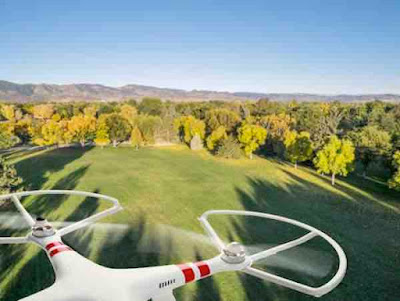Unmanned aerial systems, more commonly known as drones, have, in recent years, joined alien warships, pterodactyls, and the grim specter of death on the list of things no reasonable person wants to see hovering over his house. Though drones have many uses, they are most commonly associated with aerial surveillance: The devices are easily equipped with sophisticated cameras that can take high-resolution images from their vantage overhead. Every now and then, an aggrieved homeowner will grab a gun and try to blast a nearby drone out of the sky and, while I cannot condone these crude methods, I can understand the frustration behind them.Rico says he figures a twelve-gauge loaded with Number Four shot would handle your average drone handily...
In August of 2015, the California state legislature fired a shot of its own at the drone incursion, when it passed a bill that would make it a trespassing violation to operate a drone over private property at altitudes below 350 feet without the prior consent of the landowner. (Governor Jerry Brown has not announced whether he intends to veto the bill or sign it into law.) The bill applies to all drones, whether or not they are equipped with cameras, and this blanket prohibition makes sense if you assume that the bill’s primary objective is to give the public peace of mind. After all, a ground-dweller usually can’t tell whether a drone in flight is equipped with a camera, which makes it hard to tell whether he should be worried about being spied on, or merely annoyed that some jackass is buzzing his house without permission.
“People should be able to sit in their backyards and be in their homes without worrying about drones flying right above them or peering in their windows,” the bill’s author, state Senator Hannah-Beth Jackson, told the Guardian. “We need to balance innovation with personal and societal expectations.” That last quote seems a direct response to the tech-industry lobbyists who opposed Jackson’s bill, claiming that, if signed into law, it would stifle innovation in the drone sector. The health of that sector is of particular importance to the state of California. According to data collected by the research firm CB Insights, six of the top ten drone manufacturers, as measured by venture-capital funding levels, are based there. In a joint statement last month, the presidents of two relevant trade associations claimed that the drone industry would eventually bring California “roughly eighteen thousand new jobs and more than fourteen billion dollars in economic impact in the first decade once federal guidelines are implemented” and called Jackson’s bill “an unnecessary, innovation-stifling, and job-killing proposal.”.
But innovation counts for little if your innovative products are very, very annoying to the general public. This privacy bill is one in a suite of drone-related jackass-control measures that the California legislature has considered in recent months. In July of 2015, for example, lawmakers introduced a bill that would prohibit people from operating drones in a manner that interferes with emergency response operations, and would give emergency responders permission to dispose of drones that are in their way. The bill is a direct response to various incidents in which drones were spotted hovering in the sky above wildfires raging below; unfortunately, some emergency-response aircraft were forced to abort their missions in order to avoid mid-air collisions.
The California bills and others are efforts to fill the regulatory void left by the Federal government. There are currently no comprehensive Federal regulations to govern drone use by hobbyists. (“Individuals flying for hobby or recreation are strongly encouraged to follow safety guidelines,” according to the Federal Aviation Administration. Got it!) People who want to use drones for commercial purposes, event photography, for instance, are supposed to obtain special FAA exemptions before doing so, but anecdotal evidence suggests that more than a few commercial drone pilots haven’t bothered to comply with that rule. The FAA, supposedly, will soon issue a set of regulations that will clarify the parameters of commercial drone use, but public hostility to the intrusive devices has flourished in the meantime.
In the face of this reflexive hostility, it would seem imperative that the drones’ operators act with excessive courtesy and caution, to reassure a suspicious public that the devices are being used responsibly. But the absence of any defined code of conduct has given implicit sanction to heedless operators, and this has done great damage to the reputation of the drone industry. Take the New York man who was recently caught flying a camera-equipped drone outside the examination room of a hospital, for example; not great PR. The California drone-privacy bill itself, Senator Jackson told the Guardian, was inspired by an unpleasant experience she had on a Hawai'ian vacation. “A neighbor’s drone flew right onto the balcony and was recording our conversation. It was very unsettling,” she said.
The biggest impediment to the growth of the drone sector isn’t bills like the California privacy measure, but the lack thereof; or, more specifically, the lack of a coherent and consistent code of conduct that would promote responsible operation, penalize reckless pilots, and help shift the general public sentiment from annoyance to acceptance. Bills like the California measures, imperfect as they might be, are efforts to do what the federal government has not yet done: to impose regulatory order on an unmannered sector that will never truly take off without it.
02 September 2015
California to ban flying drones without permission
Subscribe to:
Post Comments (Atom)








No comments:
Post a Comment